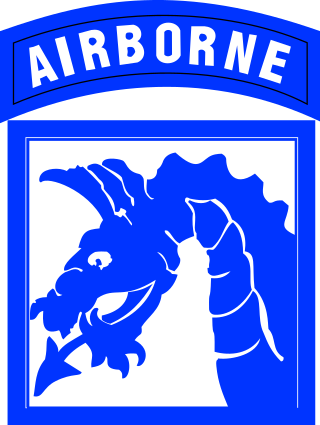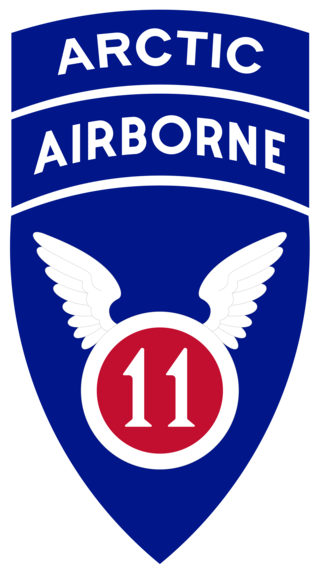
The 101st Airborne Division (Air Assault) ("Screaming Eagles") is a light infantry division of the United States Army that specializes in air assault operations. It can plan, coordinate, and execute multiple battalion-size air assault operations to seize terrain. These operations can be conducted by mobile teams covering large distances, fighting behind enemy lines, and working in austere environments with limited or degraded infrastructure. It was active in, for example, foreign internal defense and counterterrorism operations in Iraq, in Afghanistan in 2015–2016, and in Syria, as part of Operation Inherent Resolve in 2018–2021.

The XVIII Airborne Corps is a corps of the United States Army that has been in existence since 1942 and saw extensive service during World War II. The corps is designed for rapid deployment anywhere in the world and is referred to as "America's Contingency Corps." Its headquarters are at Fort Liberty, North Carolina.

The VII Army Corps of the United States Army was one of the two principal corps of the United States Army Europe during the Cold War. Activated in 1918 for World War I, it was reactivated for World War II and again during the Cold War. During both World War II and the Cold War it was subordinate to the Seventh Army, or USAREUR and was headquartered at Kelley Barracks in Stuttgart, West Germany, from 1951 until it was redeployed to the US after significant success in the Gulf War in 1991, then inactivated in 1992.

The United States Cavalry, or U.S. Cavalry, was the designation of the mounted force of the United States Army. The United States Cavalry was formally created by an act of Congress on 3 August 1861 and ceased as a distinct Army branch in 1942. The name "cavalry" continues to be used as a designation for various specific United States Army formations and functions.

The 187th Airborne Infantry Regiment (Rakkasans) is a regiment of the 101st Airborne Division.
Coalition Forces Land Component Command, or CFLCC, is a command directing all land forces of different allied countries on behalf of a combatant commander or Joint task force commander.

Multi-National Corps – Iraq (MNC-I) was a formerly multinational, later U.S. only, army corps created on 15 May 2004, fighting the Iraq War. Its superior body, the Multi-National Force-Iraq (MNF-I) had replaced Combined Joint Task Force 7 on May 15, 2004. The change was made due to "concerns that had existed for some period of time, that the Combined Joint Task Force 7 headquarters was not sufficient to handle the range of military operations in Iraq, including peace support, civil military operations, and at the same time conduct strategic engagement such as talking to the sheiks and talking to the political authorities."

The 45th Infantry Brigade Combat Team ("Thunderbird") is a modular infantry brigade combat team of the United States Army headquartered in Norman, Oklahoma. It is a part of the Oklahoma Army National Guard.

Below is an estimated list of the major units deployed within the Multi-National Force – Iraq and other United States military units that were operating in Iraq under the U.S. Central Command (USCENTCOM) in 2009, during the Iraq War.

The 256th Infantry Brigade Combat Team is a modular infantry brigade combat team (IBCT) of the Louisiana Army National Guard. It is headquartered in Lafayette, Louisiana. Currently the brigade is part of the 36th Infantry Division of the Texas Army National Guard.

Majid al Tamimi Airbase, officially known as the Tikrit Air Academy and formerly as Al Sahra Airfield is an air installation near Tikrit in northern Iraq. The installation is approximately 170 kilometers north of Baghdad and 11 kilometers west of the Tigris River. Prior to 2003, Al Sahra Airfield was the main base of the Iraqi Air Force Air Academy. The Marines from Task Force Tripoli captured the base from the Iraqi Army during the 2003 U.S. invasion of Iraq and turned it over to the United States Army who used it as the headquarters of the United States Division–North. The airfield is served by two main runways measuring 9,600 feet (2,900 m) long with a shorter runway measuring 7,200-foot (2,200 m). The Americans named the airfield after Captain Michael Scott Speicher, a United States Navy pilot who was killed in action in Iraq during the Gulf War.

In the United States (US) military, a beret flash is a shield-shaped embroidered cloth that is typically 2.25 in (5.72 cm) tall and 1.875 in (4.76 cm) wide with a semi–circular base that is attached to a stiffener backing of a military beret. These flashes—a British English word for a colorful cloth patch attached to military headgear—are worn over the left eye with the excess cloth of the beret shaped, folded, and pulled over the right ear giving it a distinctive appearance.

The 2nd Infantry Brigade Combat Team (Airborne), 11th Airborne Division is an airborne infantry brigade combat team (BCT) of the United States Army. The unit is stationed at Joint Base Elmendorf-Richardson in Anchorage, Alaska and is the only airborne brigade combat team in the Pacific Theater. It is also the newest airborne Infantry BCT and one of only five in the United States Army; the others are the three Infantry BCTs of the 82nd Airborne Division and the 173rd Airborne Brigade.
Train Advise Assist Command – East was a multinational military formation, part of NATO's Resolute Support Mission within Afghanistan. Until 2014 it was designated Regional Command East, part of the International Security Assistance Force (ISAF). The United States Army provided the force headquarters. The command headquarters was located in Laghman Province.

This is the order of battle for the ground campaign in the Gulf War between U.S. and Coalition Forces and the Iraqi Armed Forces between February 24–28, 1991. The order that they are listed in are from west to east. Iraqi units that were not in the Kuwaiti Theater of Operations are excluded from this list. Some Iraqi divisions remained un-identified by Department of Defense intelligence and a number of the details of the Iraqi order of battle are in dispute among various authoritative sources.

This is the order of battle for the invasion of Iraq during the Iraq War between coalition forces and the Iraqi Armed Forces; Fedayeen Saddam irregulars; and others between March 19 and May 1, 2003.

The Combat Aviation Brigade, 3rd Infantry Division is the Combat Aviation Brigade of the 3rd Infantry Division of the United States Army based at Fort Stewart.
Combined Joint Task Force 180 was a provisional multinational land formation, primarily made up of units from the United States Army, that fought in the War in Afghanistan (2001–2021), especially in the initial invasion phase of 2001-2002. It was active from May 2002 to 2003/05. It was the senior headquarters in country reporting to United States Central Command.















